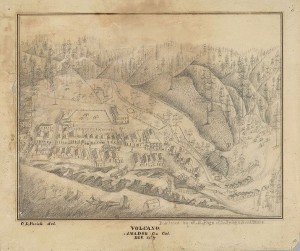Amador County calls itself “the heart of the mother lode” and a twenty-mile long belt of gold ran through the western part of the county from Plymouth, through Drytown, Amador City, and Sutter Creek, then on to Jackson. It was this golden belt that sustained the hard rock mines here for a 100 years.
Amador’s Daffodil hill reflects the color of the mother lode, photographed by Agunther.
But the earliest mining started in the spring of 1848 in the gravel beds along Dry Creek. The oldest town in the county, Drytown, rose around those early diggings. By the middle of November there were 25–30 cabins, stores, and saloons beside Dry Creek. In 1856 quartz mines were found and the settlement grew but two years later an arson fire, set as a result of racial tension, burned the town and it never recovered.
The county was named for Jose Maria Amador, the owner of the Rancho San Ramon, a land grant that encompassed today’s Danville, San Ramon and Dublin, who, with his sons and some Indian workers, mined the area around Amador City in 1848. He returned to his home near Alamilla Springs in today’s Dublin with three mules loaded with gold. He gave tin cups full to his workers and spread the remainder among his relatives.
In 1849 former soldiers of Colonel Stevenson’s regiment prospected in a bowl like valley. The town that sprang up was first called Soldier Gulch but because many thought the valley was a volcano that was the name that stuck. By 1853 Volcano had 11 stores, six hotels and three saloons. When hydraulic mining began in 1855 the town grew to 17 hotels.
Plymouth, once called Pokerville or Poker Camp, is now known as the gateway to Amador County’s Shenandoah Valley, once the principal wine growing area in California. Some wineries date back to 1869. The decline in gold mining, followed by prohibition, took a bite out of wine production here. Today the region is not as well known as the Napa or Sonoma Valleys but is still famous for its Zinfandels.



















I am looking for information concerning Albert Putnam and Put’s Bar=
I am interested in the family genealogy also since I am related to the Leach/Leech side of the family.
Any information would be appreciated.
Thanks
Betty
Hi Betty, your note interested me especially because of the name. I did a little research and maybe I can help a little. I found two references to Albert Putnam, one in the 1850 census where he is listed in Calaveras County and the second in the 1860 census where he has moved to Amador county and is working his mine at Put’s Bar. Bill Putman.com is a great resource. I’ve traced my family roots back to the middle 1600s through it. Perhaps you can find more information there on Albert if you start at the beginning.
Here is the url for the census listing. Good luck.
http://www.billputman.com/California%20Census%201850-1900.htm
Hi John.Thanks for the information, I have seen the census before and know a little about where they lived but I would like to know more about the family history-Albert Putnam was married to my great aunt-My family comes from the Ione area and would be interested in any of the Putnam information you could give me-
Betty
Hi Betty,
Unfortunately I really don’t know much about Albert and his line. They are from New England and my side of the family is from the south but Bill Putman has done extensive research on both branches of the family and I strongly suspect you can find your relatives on his site. Certainly Albert is there. Go to http://www.billputman.com/ then click on genealogy and family history, Putnam and Putman families, New England Putnam Families and then you’ll need to figure out which generation Albert was in and start there. Where the web site will take you I don’t know, but I followed my family from near Jamestown in the mid 1600’s all the way up to my father. Good luck to you. Here is the census data again.
http://www.billputman.com/California%20Census%201850-1900.htm
John